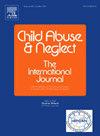家庭暴力对中国儿童和青少年校园欺凌代际传播的风险和影响
IF 3.4
2区 心理学
Q1 FAMILY STUDIES
引用次数: 0
摘要
家庭暴力——包括虐待儿童和父母之间的暴力——是一个普遍存在的全球公共卫生问题,对儿童和青少年的影响尤为严重。在中国,目前和具有全国代表性的患病率估计仍然很少,妨碍了以证据为基础的预防。目的本研究考察了中国儿童和青少年中只目睹、只经历以及同时目睹和经历家庭暴力的流行程度和后果,并特别关注校园欺凌。它探讨了不同的暴露模式如何塑造欺凌行为,将累积影响作为一种独特的代际传播形式。方法从2022年11月至2023年5月的年度心理健康监测系统中收集数据。参与者根据一生中遭受家庭暴力的情况被分为四组:没有家庭暴力、只目睹家庭暴力、只经历家庭暴力、既目睹又经历家庭暴力。结果仅目睹家庭暴力者的终身患病率为5.9%,仅经历过家庭暴力者的终身患病率为14.7%,同时目睹和经历过家庭暴力者的终身患病率为6.8%。暴露于家庭暴力对欺凌行为表现出累积效应,从仅目睹暴力(OR = 2.426, p < 0.001)、仅经历暴力(OR = 4.329, p < 0.001)到目睹和经历暴力(OR = 7.062, p < 0.001),欺凌的几率逐渐增加。值得注意的是,暴露于两种形式暴力的青少年表现出最高的校园欺凌行为风险。结论解决家庭暴力问题对于保障儿童和青少年的心理健康至关重要。针对家庭环境和学校环境的综合干预措施对于减轻暴力的传播和改善青少年的心理结果至关重要。本文章由计算机程序翻译,如有差异,请以英文原文为准。
The risk and impact of family violence on the intergenerational transmission of school bullying among Chinese children and adolescents
Background
Family violence—comprising both child maltreatment and interparental violence—is a pervasive global public-health concern that disproportionately affects children and adolescents. In China, current and nationally representative prevalence estimates remain scarce, impeding evidence-based prevention.
Objective
This study examines the prevalence and consequences of witnessing only, experiencing only, and concurrently witnessing and experiencing family violence among Chinese children and adolescents, with a specific focus on school bullying. It explores how distinct patterns of exposure shape bullying behaviors, framing the cumulative impact as a unique form of intergenerational transmission.
Methods
Data were collected from an annual mental health surveillance system between November 2022 and May 2023. Participants were categorized into four groups based on lifetime family violence exposure: no exposure, witnessing only, experiencing only, and both witnessing and experiencing violence.
Results
The lifetime prevalence rates were 5·9 % for witnessing family violence only, 14·7 % for experiencing family violence only, and 6·8 % for concurrent witnessing and experiencing of family violence. Exposure to family violence showed cumulative effects on bullying behaviors, with odds of bullying increasing progressively from witnessing only (OR = 2·426, p < 0·001), experiencing abuse only (OR = 4·329, p < 0·001), to both witnessing and experiencing violence (OR = 7·062, p < 0·001). Notably, adolescents exposed to both forms of violence exhibited the highest risk for school bullying perpetration.
Conclusions
Addressing family violence is critical for safeguarding the mental health of children and adolescents. Comprehensive interventions targeting family environments and school settings are essential to mitigate the transmission of violence and improve psychological outcomes among youth.
求助全文
通过发布文献求助,成功后即可免费获取论文全文。
去求助
来源期刊

Child Abuse & Neglect
Multiple-
CiteScore
7.40
自引率
10.40%
发文量
397
期刊介绍:
Official Publication of the International Society for Prevention of Child Abuse and Neglect. Child Abuse & Neglect The International Journal, provides an international, multidisciplinary forum on all aspects of child abuse and neglect, with special emphasis on prevention and treatment; the scope extends further to all those aspects of life which either favor or hinder child development. While contributions will primarily be from the fields of psychology, psychiatry, social work, medicine, nursing, law enforcement, legislature, education, and anthropology, the Journal encourages the concerned lay individual and child-oriented advocate organizations to contribute.
 求助内容:
求助内容: 应助结果提醒方式:
应助结果提醒方式:


